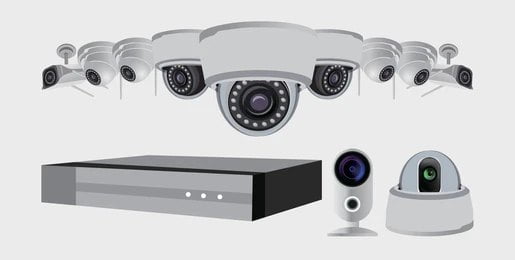Surveillance technology has advanced greatly, evolving from basic analogue systems to sophisticated digital solutions. At the heart of modern surveillance are Network Video Recorders (NVR) and Digital Video Recorders (DVR), which are crucial in capturing, storing, and managing video footage. As we look to the future, it’s essential to understand the trends shaping the next generation of NVR and DVR technology. This comprehensive guide explores these trends, providing valuable insights for businesses and individuals aiming to stay ahead in surveillance.
The Evolution of Surveillance Technology

Historical Overview of NVR and DVR Systems
Surveillance technology has undergone significant transformations over the decades. Initially, analogue systems dominated the landscape, relying on Video Cassette Recorders (VCRs) to capture footage. These systems were limited by their reliance on physical tapes, which required manual handling and had limited storage capacity.
Introducing Digital Video Recorders (DVRs) marked a significant leap forward. DVRs digitized the recording process, storing footage on hard drives instead of tapes. This shift brought several benefits, including improved video quality, easier access to recorded footage, and the ability to search and playback videos more efficiently. However, DVRs still relied on coaxial cables to connect cameras, which limited their flexibility and scalability.
Network Video Recorders (NVRs) emerged as the next evolution in surveillance technology. Unlike DVRs, NVRs operate over IP networks, allowing for greater flexibility and scalability. NVRs can connect to IP cameras over a network, enabling remote access and management. This transition to network-based systems has paved the way for advanced features such as higher-resolution recording, integration with other network devices, and enhanced data security.
Current State of NVR and DVR Technology
Today, NVR and DVR systems have become more sophisticated, offering a range of features that cater to various surveillance needs. Modern DVR systems continue to be popular in environments with existing analogue infrastructure. They offer high-definition recording, advanced compression techniques to save storage space, and user-friendly interfaces for easy management.
NVR systems, on the other hand, are favoured for new installations and environments that require high flexibility and scalability. NVRs support higher video resolutions, often up to 4K and beyond, and can integrate with many IP cameras and network devices. They also offer advanced analytics capabilities, such as motion detection, facial recognition, and object tracking, which enhance security and operational efficiency.
Comparative Analysis: NVR vs. DVR in Today’s Market
| Feature | DVR | NVR |
|---|---|---|
| Video Quality | High-definition (HD) | Ultra HD, 4K, 8K |
| Connection | Coaxial cables | IP network |
| Scalability | Limited to number of ports | Highly scalable, network-based |
| Flexibility | Fixed camera positions | Flexible, supports wireless |
| Analytics | Basic motion detection | Advanced AI-driven analytics |
| Storage | Local hard drives | Local, cloud, or hybrid |
| Remote Access | Limited | Extensive, via web and mobile |
NVR and DVR systems have their place in the market, each offering unique advantages depending on the specific requirements of the surveillance application. As technology advances, the lines between NVR and DVR capabilities are blurring, with hybrid systems emerging that combine the best features.
Emerging Trends in NVR and DVR Technology
AI and Machine Learning Integration
Artificial Intelligence (AI) and Machine Learning (ML) are revolutionizing the surveillance industry by enhancing the capabilities of NVR and DVR systems. AI-driven features such as facial recognition, object detection, and behavioural analysis are becoming standard in modern surveillance solutions.
Facial recognition technology allows NVR and DVR systems to identify individuals in real time, particularly useful for access control and identifying potential threats. Object detection can distinguish between different types of objects, such as vehicles, animals, or people, enabling more precise monitoring and reducing false alarms.
Behavioural analysis uses machine learning algorithms to detect unusual patterns of behaviour, such as loitering or unauthorized access. This proactive approach helps prevent incidents before they occur, enhancing overall security.
Case Study:
A retail store implemented an NVR system with AI capabilities to monitor customer behaviour. The system identified patterns such as frequent visits to specific aisles, helping the store optimize product placement and improve customer experience. Additionally, the system could detect suspicious activities, such as shoplifting, and alert security personnel in real time.
Cloud-Based Surveillance Solutions
The shift towards cloud-based surveillance solutions is another significant trend in NVR and DVR technology. Cloud storage offers several advantages over traditional local storage, including scalability, remote access, and enhanced data security.
Benefits of cloud-based NVR and DVR systems:
- Scalability: Easily expand storage capacity without the need for additional hardware.
- Remote Access: Access and manage footage from anywhere, using web or mobile applications.
- Data Security: Cloud providers offer robust security measures, including encryption and regular backups, to protect data from unauthorized access and loss.
Challenges and Considerations:
- Bandwidth Requirements: High-resolution video requires significant bandwidth, which can be challenging in areas with limited internet connectivity.
- Cost: While cloud storage can reduce hardware costs, ongoing subscription fees can increase over time.
- Privacy Policy Statement on Data Privacy: Storing sensitive footage in the cloud raises concerns about data privacy and compliance with regulations such as GDPR.
Enhanced Video Quality and Resolution
The demand for higher video quality and resolution continues to drive advancements in NVR and DVR technology. 4K and 8K video resolutions are becoming more common, offering unparalleled clarity and detail.
Implications of higher resolution:
- Storage Requirements: Higher-resolution videos require more storage space. Advanced compression techniques, such as H.265, help mitigate this by reducing file sizes without compromising quality.
- Bandwidth Consumption: Streaming high-resolution video consumes more bandwidth, necessitating robust network infrastructure.
- Improved Analytics: Higher resolution footage enhances the accuracy of AI-driven analytics, such as facial recognition and object detection.
Future Prospects:
The push for even higher resolutions, such as beyond 8K, is on the horizon. This will further enhance the capabilities of surveillance systems, enabling detailed monitoring over larger areas and improving the effectiveness of analytics.
Improved Data Security and Privacy
As surveillance systems become more advanced, the importance of data security and privacy cannot be overstated. Emerging security protocols and technologies are being integrated into NVR and DVR systems to protect against cyber threats and ensure compliance with privacy regulations.
Key security features:
- Data Encryption: Encrypting video data both at rest and in transit to prevent unauthorized access.
- Access Control: Implementing multi-factor authentication (MFA) and role-based access control to restrict access to sensitive data.
- Regular Updates: Ensuring systems are regularly updated with the latest security patches to protect against vulnerabilities.
Balancing Surveillance Needs with Privacy Concerns:
Surveillance systems must strike a balance between security and privacy. This involves implementing measures to protect individual privacy, such as masking sensitive areas in video footage and ensuring compliance with regulations like GDPR.
IoT and Smart Surveillance Systems
Integrating NVR and DVR systems with the Internet of Things (IoT) transforms surveillance into a more interconnected and intelligent ecosystem. Smart surveillance systems leverage IoT devices to enhance monitoring and response capabilities.
Applications of IoT in surveillance:
- Smart Home Security: Integrating NVR/DVR systems with smart home devices, such as doorbells and sensors, to provide comprehensive home security solutions.
- Smart Cities: Deploying interconnected surveillance networks across urban areas to improve public safety and traffic management.
- Industrial Monitoring: Using IoT sensors to monitor critical infrastructure and detect real-time anomalies.
Future of Interconnected Surveillance Networks:
The continued growth of IoT will lead to more sophisticated and integrated surveillance solutions, enabling real-time data sharing and enhanced situational awareness.
Edge Computing and On-Device Processing
Edge computing is emerging as a game-changer in surveillance technology. NVR and DVR systems can deliver real-time analytics and reduce latency by processing data at the edge near where it is generated.
Advantages of edge computing:
- Real-Time Processing: Immediate analysis of video data, enabling faster response times.
- Reduced Bandwidth: Minimizing the need to transmit large volumes of data to central servers, reducing bandwidth consumption.
- Enhanced Privacy: Keeping data processing local enhances privacy by limiting the amount of sensitive data transmitted over networks.
Case Studies:
Several organizations have successfully implemented edge computing in their surveillance systems. For example, a manufacturing plant used edge-based NVR systems to monitor production lines in real-time, detecting defects and improving quality control.
Scalability and Flexibility
Modern NVR and DVR systems are designed to be modular and scalable, allowing businesses to adapt their surveillance infrastructure to changing needs.
Features of scalable systems:
- Modular Design involves adding or removing components, such as cameras and storage units, without disrupting the system.
- Flexible Deployment: Supporting various environments, from small businesses to large enterprises, with tailored solutions.
- Future-Proofing: Ensuring systems can be easily upgraded to incorporate new technologies and features.
Adapting to Different Environments:
Scalable NVR and DVR systems can be customized to meet the specific requirements of different environments. For instance, a small retail store might need a basic setup with a few cameras and limited storage. At the same time, a large corporate campus might require an extensive network of cameras, advanced analytics, and significant storage capacity. This flexibility ensures businesses can invest in a solution that fits their current needs while allowing for future expansion.
Integration with Other Security Systems
Modern NVR and DVR systems are increasingly integrated with other security systems to create a comprehensive security ecosystem. This integration enhances the overall effectiveness of surveillance by providing a holistic view of security operations.
Common integrations include:
- Access Control Systems: Linking surveillance cameras with access control systems to monitor and manage real-time entry points.
- Intrusion Detection Systems: Coordinating with sensors and alarms to provide immediate alerts and visual verification of security breaches.
- Fire and Safety Systems: Integrating fire alarms and smoke detectors to ensure rapid emergency response.
- Building Management Systems (BMS): Combining surveillance with HVAC, lighting, and other building systems for improved operational efficiency and security.
Benefits of Integrated Security Solutions:
- Enhanced Situational Awareness: Providing a comprehensive view of security incidents by combining data from multiple sources.
- Improved Response Times: Enabling faster and more coordinated responses to incidents through automated alerts and integrated workflows.
- Cost Efficiency: Reducing the need for multiple standalone systems and streamlining maintenance and management processes.
User-Friendly Interfaces and Mobile Accessibility
As surveillance technology advances, the importance of user-friendly interfaces and mobile accessibility is becoming more pronounced. Modern NVR and DVR systems are designed with intuitive interfaces that make it easy for users to navigate and manage their surveillance footage.
Key features of user-friendly interfaces:
- Dashboard Views: Providing a centralized view of all cameras and alerts makes monitoring multiple feeds easy.
- Search and Playback: Offering advanced search capabilities to quickly locate specific footage based on time, date, or detected events.
- Customization: Allowing users to customize their interface and settings to match their needs and preferences.
Mobile Accessibility:
- Remote Monitoring: Enable users to access live feeds and recorded footage from their smartphones or tablets, regardless of location.
- Push Notifications: Sending real-time alerts to mobile devices in case of detected incidents, ensuring timely responses.
- Mobile Apps: Providing dedicated apps with full functionality, including camera control, playback, and system management.
Case Study:
A logistics company implemented an NVR system with a user-friendly interface and mobile accessibility. The system allowed managers to monitor warehouse operations remotely, improving oversight and reducing the risk of theft and operational inefficiencies. The mobile app provided instant alerts for security breaches, enabling quick action even when managers were off-site.
Sustainability and Energy Efficiency
Sustainability and energy efficiency are becoming increasingly important considerations in designing and deploying NVR and DVR systems. As businesses strive to reduce their environmental impact, surveillance technology is evolving to support these goals.
Energy-Efficient Features:
- Low Power Consumption: Designing systems that consume less power without compromising performance.
- Smart Power Management: Implementing sleep modes and automated power adjustments based on usage patterns.
- LED Technology: Utilizing energy-efficient LED indicators and displays.
Sustainable Practices:
- Recyclable Materials: Using recyclable and eco-friendly materials to manufacture NVR and DVR systems.
- Reduced E-Waste: Designing systems with longer lifespans and modular components that can be upgraded or replaced individually, reducing electronic waste.
- Green Certifications: Adhering to environmental standards and obtaining certifications such as ENERGY STAR and RoHS compliance.
Future Directions:
The focus on sustainability is expected to drive further innovations in NVR and DVR technology, with advancements in energy-efficient hardware, renewable energy integration, and eco-friendly manufacturing processes.
The future of NVR and DVR technology is shaped by myriad trends that enhance the capabilities and applications of surveillance systems. From AI and machine learning integration to cloud-based solutions, higher video resolutions, and improved data security, these advancements are transforming how we approach security and monitoring.
As businesses and individuals adopt these cutting-edge technologies, they can expect to benefit from more efficient, scalable, and intelligent surveillance systems. Staying informed about these trends and understanding their implications will be crucial for leveraging the full potential of NVR and DVR technology in the years to come.
Practical Considerations for Implementing NVR and DVR Systems
Various practical aspects must be considered to ensure a successful deployment when implementing NVR (Network Video Recorder) and DVR (Digital Video Recorder) systems. This section discusses key considerations, including system selection, installation, maintenance, and regulation compliance.
System Selection
Choosing the right NVR or DVR system is critical to meeting your surveillance needs. Here are some factors to consider:
1. Purpose and Requirements:
- Application: Determine whether the system will be used for residential, commercial, industrial, or public safety purposes.
- Number of Cameras: Assess the number of cameras needed and ensure the system can support future expansion.
- Resolution and Frame Rate: Decide on the required video quality and frame rate based on the surveillance needs.
2. Technology:
- NVR vs. DVR: NVR systems are generally more flexible and scalable, supporting IP cameras, while DVR systems are typically used with analog cameras.
- Compatibility: Ensure the system is compatible with existing cameras and other security devices.
- Storage Capacity: Evaluate the storage requirements based on the number of cameras, resolution, and retention period.
3. Features:
- AI and Analytics: Look for systems with advanced analytics, such as facial recognition, motion detection, and behavioural analysis.
- Remote Access: Ensure the system supports remote monitoring and management via mobile apps or web interfaces.
- Integration: Check if the system can integrate with other security systems, such as access control and intrusion detection.
Installation
Proper installation is crucial for the optimal performance of NVR and DVR systems. Here are some best practices:
1. Site Assessment:
- Layout: Conduct a thorough site assessment to determine the best locations for cameras and recording equipment.
- Coverage: Ensure cameras cover all critical areas without blind spots.
- Environmental Factors: Consider environmental conditions, such as lighting, weather, and potential obstructions.
2. Network Infrastructure:
- Bandwidth: Ensure sufficient network bandwidth to handle video data, especially for high-resolution cameras.
- Wiring: Use high-quality cables and connectors to prevent signal loss and ensure reliable connections.
- Power Supply: Provide adequate power supplies, including backup options like UPS (Uninterruptible Power Supply) to prevent downtime.
3. Camera Placement:
- Height and Angle: Position cameras at appropriate heights and angles to capture clear and comprehensive footage.
- Protection: Install cameras in weatherproof enclosures if exposed to outdoor elements.
- Lighting: Ensure adequate lighting for cameras, especially in low-light conditions, or use cameras with night vision capabilities.
Maintenance
Regular maintenance is essential to keep NVR and DVR systems functioning effectively. Key maintenance activities include:
1. Routine Checks:
- Hardware Inspection: Regularly inspect cameras, cables, and recording devices for signs of wear or damage.
- Software Updates: Keep firmware and software up to date to ensure the system benefits from the latest features and security patches.
2. Data Management:
- Storage Monitoring: Monitor storage usage and ensure enough capacity for continuous recording.
- Backup: Implement regular backup procedures to prevent data loss in case of hardware failure or other issues.
- Retention Policies: Set and review data retention policies to ensure compliance with legal and organizational requirements.
3. Performance Optimization:
- System Health: To ensure optimal performance, regularly check the system’s health, including CPU and memory usage.
- Cleaning: Clean camera lenses and other equipment to maintain clear image quality.
- Testing: Periodically test the system, including cameras, recording, and alert functionalities, to ensure everything works as expected.
Compliance and Legal Considerations
Implementing surveillance systems involves adhering to various legal and regulatory requirements. Key considerations include:
1. Privacy Laws:
- Notification: Inform individuals that they are being recorded, typically through signage.
- Consent: Obtain consent where required, especially in private or sensitive areas.
- Data Protection: Ensure compliance with data protection regulations, such as GDPR, which govern the collection, storage, and use of video footage.
2. Industry Standards:
- Security Standards: Adhere to industry standards for security, such as encryption and access control, to protect video data.
- Certification: Consider systems certified by recognized standards, ensuring they meet specific performance and security criteria.
3. Record Keeping:
- Documentation: Maintain detailed system installation, configuration, and maintenance records.
- Access Logs: Keep logs of who accesses the system and video footage to maintain accountability and traceability.
Implementing NVR and DVR systems requires careful planning and consideration of various factors, from selecting the right system to ensuring proper installation, maintenance, and compliance with legal requirements. Organizations can deploy effective surveillance solutions that enhance security and operational efficiency by addressing these practical considerations.
Advanced Features and Innovations in NVR and DVR Systems
As technology evolves, NVR (Network Video Recorder) and DVR (Digital Video Recorder) systems incorporate advanced features and innovations that significantly enhance their capabilities. This section explores some of the latest advancements in surveillance technology.
Artificial Intelligence and Machine Learning
Artificial Intelligence (AI) and Machine Learning (ML) are revolutionizing NVR and DVR systems by enabling more intelligent and automated surveillance solutions.
Key AI and ML Features:
- Facial Recognition: This technique identifies and verifies individuals based on facial features, which is useful for access control and identifying persons of interest.
- Object Detection and Tracking: Recognizes and tracks objects such as vehicles, bags, or animals, providing detailed information about their movements.
- Behaviour Analysis: Analyzes patterns of behaviour to detect anomalies, such as loitering, crowd formation, or aggressive actions.
- License Plate Recognition (LPR): Automatically reads and records vehicle license plates, useful for parking management and security.
Benefits:
- Enhanced Accuracy: AI and ML algorithms improve the accuracy of detecting and identifying events, reducing false alarms.
- Automated Alerts: Systems can automatically generate alerts for specific events, enabling faster response times.
- Data Insights: Advanced analytics provide valuable insights into trends and patterns, aiding decision-making and resource allocation.
Cloud-Based Solutions
Cloud technology transforms how video surveillance data is stored, managed, and accessed.
Cloud-Based Features:
- Scalable Storage: This option offers unlimited storage capacity, allowing organizations to store large amounts of video data without needing extensive on-premises infrastructure.
- Remote Access: This feature allows users to access live and recorded footage from anywhere with an internet connection, enhancing flexibility and convenience.
- Data Redundancy: Ensures data redundancy and disaster recovery options, protecting video footage from loss due to hardware failure or other issues.
Benefits:
- Cost Efficiency: Reduces the need for expensive on-site storage solutions and maintenance.
- Flexibility: Easily scales up or down based on storage needs, accommodating changing requirements.
- Enhanced Security: Cloud providers often offer advanced security measures, including encryption and secure access controls.
High-Resolution and Multi-Sensor Cameras
Advancements in camera technology provide higher resolution and multi-sensor capabilities, improving the quality and coverage of surveillance footage.
High-Resolution Cameras:
- 4K and Beyond: Cameras with 4K resolution and higher provide exceptionally clear and detailed images, useful for identifying fine details.
- Wide Dynamic Range (WDR): Enhances image quality in challenging lighting conditions, balancing bright and dark areas.
Multi-Sensor Cameras:
- Panoramic Views: Multi-sensor cameras combine multiple lenses to provide 180-degree or 360-degree views, reducing the number of cameras needed for comprehensive coverage.
- Directional Monitoring: This allows for monitoring multiple directions simultaneously, which is useful for large open areas like parking lots and stadiums.
Benefits:
- Improved Detail: Higher resolution cameras capture more detail, aiding in identification and forensic analysis.
- Reduced Blind Spots: Multi-sensor cameras provide broader coverage, minimizing blind spots and enhancing situational awareness.
Cybersecurity Enhancements
Cybersecurity has become a critical focus area with the increasing connectivity of surveillance systems.
Cybersecurity Features:
- Encryption: Encrypts video data both in transit and at rest to protect against unauthorized access.
- Access Control: Implements robust access control mechanisms to restrict who can access and manage the surveillance system.
- Firmware Updates: Regularly updates firmware to patch vulnerabilities and enhance security features.
Benefits:
- Data Protection: Protects sensitive video data from cyber threats and breaches.
- Compliance: Helps organizations comply with cybersecurity regulations and standards.
- System Integrity: Maintain the surveillance system’s integrity and reliability by preventing unauthorized modifications.
Edge Computing
Edge computing involves processing data closer to the source (e.g., within the camera) rather than relying solely on central servers.
Edge Computing Features:
- On-Device Analytics: Performs analytics directly on the camera, reducing the need for bandwidth and central processing power.
- Real-Time Processing: Enables real-time video data processing, providing immediate insights and alerts.
- Bandwidth Efficiency: Reduces the amount of data transmitted over the network by processing and filtering data at the edge.
Benefits:
- Reduced Latency: Provides faster response times by processing data locally.
- Cost Savings: Lowers bandwidth and central processing costs by minimizing data transmission.
- Scalability: Enhances the scalability of surveillance systems by distributing processing tasks across multiple devices.
Conclusion
Integrating advanced features and innovations in NVR and DVR systems transforms the video surveillance landscape. AI and ML, cloud-based solutions, high-resolution and multi-sensor cameras, enhanced cybersecurity, and edge computing are just a few of the advancements driving this evolution. Organizations can achieve more effective, efficient, and secure surveillance solutions by leveraging these technologies.










